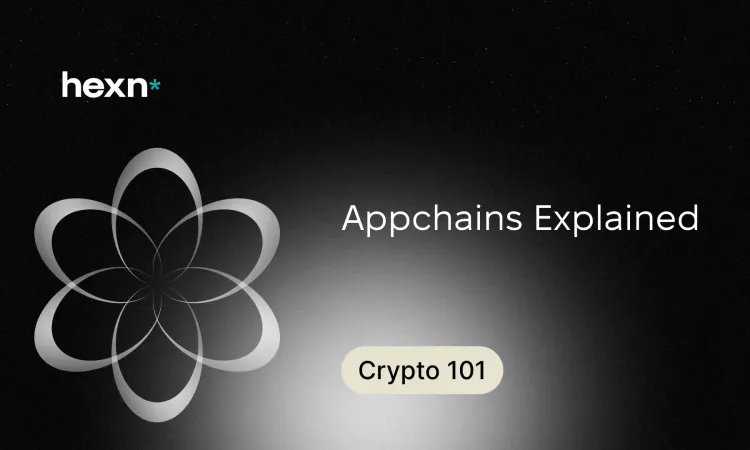Appchains Explained
Appchains are blockchains built to serve a single application or a narrow set of use cases. By tailoring rules, fees, and resources to one purpose, they can boost performance, lower latency, and offer developers more control than one-size-fits-all networks.
- Specialization: Appchains dedicate chain resources to a specific application.
- Scalability: They can increase throughput and reduce congestion for targeted workloads.
- Flexibility: Modular design and configurable consensus let teams optimize for their requirements.
What Is an Appchain?
An appchain is a standalone or connected blockchain created to run a particular application or service. Instead of sharing capacity with many unrelated projects, an appchain focuses its processing, storage, and governance on a single product — for example, a gaming economy, a complex DeFi protocol, or a supply-chain platform. Teams pick appchains when predictable performance, custom rule sets, or bespoke tokenomics are more important than being on a general-purpose network.
How Appchains Work
Appchains rely on the same fundamentals as other blockchains — distributed state, validators or miners, and cryptographic proofs — but they let developers change the details. Choices about consensus, transaction fee models, and smart contract languages are made to match the application’s needs rather than to satisfy a broad user base.
Common customizations include:
- Consensus selection: Picking a consensus method that balances finality, security, and cost for the app’s traffic pattern.
- Fee and throughput tuning: Setting transaction fees and block sizes to prioritize certain operations or user experiences.
- Contract tooling: Using smart contracts or execution environments designed for the app’s logic.
Many full-featured appchains are organized into distinct technical layers that separate responsibilities and make customization easier.
- Network layer: Manages peer-to-peer communication so nodes can propagate transactions and blocks.
- Application layer: Hosts the app code and runtime interfaces developers use to build and operate the service.
- Data layer: Stores the ledger, transaction history, and contract state in an efficient, verifiable way.
- Consensus layer: Implements the protocol for how participants agree on the chain state.
- Smart contract layer: Executes automated agreements and business logic specific to the application.
Practical Benefits of Appchains
Scalability Tailored to the Application
Because an appchain serves a narrow workload, it can be optimized to handle high volumes of the app’s own transactions without competing traffic. That means fewer delays and more consistent performance for end users.
Modularity and Customization
Modular design lets developers swap components — consensus mechanisms, execution environments, or fee systems — to match technical and business priorities. This flexibility is useful when standard networks impose constraints that slow innovation.
Interoperability and Composability
Many appchains are designed to communicate with other blockchains or services, enabling assets and data to move between apps while preserving the benefits of a purpose-built chain.
How Appchains Compare to Layer 1 Blockchains
Architecture Differences
Layer 1 networks are general-purpose and follow a single set of rules for all participants. Appchains, by contrast, can be independent or connected to a host network and are configured to meet one application’s needs rather than a broad ecosystem’s.
Consensus Flexibility
Appchains can select or modify consensus algorithms to prioritize speed, cost, or security based on their use case. Layer 1 chains usually stick with a fixed consensus model that balances these trade-offs across many applications.
Scalability Trade-Offs
Because layer 1 platforms serve many projects, they sometimes hit capacity limits. Appchains avoid that by isolating application traffic, but they may need additional design work to match the host network’s security guarantees.
Appchains vs Sidechains
Sidechains are separate chains that connect to a main network and handle a range of tasks. Appchains differ because they are purpose-built for a single application or narrowly focused group of apps. In short, sidechains are multipurpose; appchains are specialized.
Examples of Appchains
Parachain-Style Appchains
Some multi-chain frameworks enable parallel blockchains that plug into a shared security layer. These parachain-like chains can run custom logic, economics, and governance while benefiting from shared safety.
Subnet-Style Appchains
Networks that support subnets allow independent groups of validators to maintain application-specific chains. Subnets are useful when validators want to isolate operations or enforce bespoke policies.
Zone-Style Appchains
Other ecosystems use zones — independent chains linked through messaging protocols — so apps can maintain their own state and still exchange tokens or data across the broader network.
Final Takeaways
Appchains give teams a way to build with predictable performance and full control over protocol choices. They shine when an application needs tailored transaction handling, unique governance, or dedicated economic incentives. However, developers should weigh the additional complexity and security considerations against the performance gains before committing to a dedicated chain.
